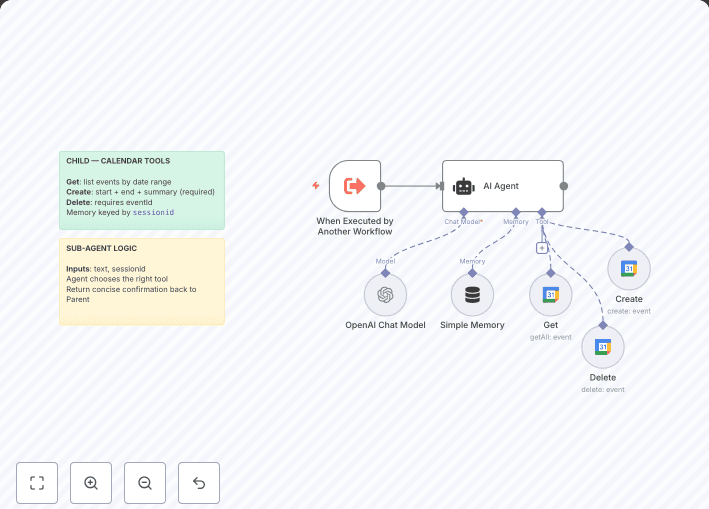Telegram Personal Assistant with Long-Term Memory & Note-Taking
This n8n workflow transforms your Telegram bot into a powerful personal assistant that handles voice, photo, and text messages. The assistant uses AI to interpret messages, save important details as long-term memories or notes in a Baserow database, and recall information for future interactions.
🌟 How It Works
-
Message Reception & Routing
- Telegram Integration: The workflow is triggered by incoming messages on your Telegram bot.
- Dynamic Routing: A switch node inspects the message to determine whether it's voice, text, or photo (with captions) and routes it for the appropriate processing.
-
Content Processing
- Voice Messages: Audio files are retrieved and sent to an AI transcription node to convert spoken words into text.
- Text Messages: Text is directly captured and prepared for analysis.
- Photos: If an image is received, the bot fetches the file (and caption, if provided) and uses an AI-powered image analysis node to extract relevant details.
-
AI-Powered Agent & Memory Management
- The core AI agent (powered by GPT-4o-mini) processes the incoming message along with any previous conversation history stored in PostgreSQL memory buffers.
- Long-Term Memory: When a message contains personal or noteworthy information, the assistant uses a dedicated tool to save this data as a long-term memory in Baserow.
- Note-Taking: For specific instructions or reminders, the assistant saves concise notes in a separate Baserow table.
- The AI agent follows defined rules to decide which details are saved as memories and which are saved as notes.
-
Response Generation
- After processing the message and updating memory/notes as needed, the AI agent crafts a contextual and personalized response.
- The response is sent back to the user via Telegram, ensuring smooth and natural conversation flow.
🚀 Key Features
-
Multimodal Input:
Seamlessly handles voice, photo (with captions), and text messages.
-
Long-Term Memory & Note-Taking:
Uses a Baserow database to store personal details and notes, enhancing conversational context over time.
-
AI-Driven Contextual Responses:
Leverages an AI agent to generate personalized, context-aware replies based on current input and past interactions.
-
User Security & Validation:
Incorporates validation steps to verify the user's Telegram ID before processing, ensuring secure and personalized interactions.
-
Easy Baserow Setup:
Comes with a clear setup guide and sample configurations to quickly integrate Baserow for managing memories and notes.
🔧 Setup Guide
-
Telegram Bot Setup:
- Create your bot via BotFather and obtain the Bot Token.
- Configure the Telegram webhook in n8n with your bot's token and URL.
-
Baserow Database Configuration:
- Memory Table:
- Create a workspace titled "Memories and Notes".
- Set up a table (e.g., "Memory Table") with at least two fields:
- Memory (long text)
- Date Added (US date format with time)
- Notes Table:
- Duplicate the Memory Table and rename it to "Notes Table".
- Change the first field's name from "Memory" to "Notes".
-
n8n Workflow Import & Configuration:
- Import the workflow JSON into your n8n instance.
- Update credentials for Telegram, Baserow, OpenAI, and PostgreSQL (for memory buffering) as needed.
- Adjust node settings if you need to customize AI agent prompts or memory management rules.
-
Testing & Deployment:
- Test your bot by sending various message types (text, voice, photo) to confirm that the workflow processes them correctly, updates Baserow, and returns the appropriate response.
- Monitor logs to ensure that memory and note entries are correctly stored and retrieved.
✨ Example Interactions
🛠️ Resources & Next Steps
This workflow not only streamlines message processing but also empowers users with a personal AI assistant that remembers details over time. Customize the rules and responses further to fit your unique requirements and enjoy a more engaging, intelligent conversation experience on Telegram!


